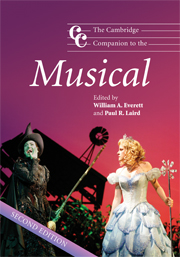Book contents
- Frontmatter
- Part I Adaptations and transformations: before 1940
- 1 American musical theatre before the twentieth century
- 2 Non-English-language musical theatre in the United States
- 3 Birth pangs, growing pains and sibling rivalry: musical theatre in New York, 1900–1920
- 4 American and British operetta in the 1920s: romance, nostalgia and adventure
- 5 Images of African Americans: African-American musical theatre, Show Boat and Porgy and Bess
- 6 The melody (and the words) linger on: American musical comedies of the 1920s and 1930s
- Part II Maturations and formulations: 1940–1970
- Part III Evolutions and integrations: after 1970
- Part IV Legacies and transformations
- Notes
- Select bibliography
- Index
2 - Non-English-language musical theatre in the United States
from Part I - Adaptations and transformations: before 1940
Published online by Cambridge University Press: 28 September 2011
- Frontmatter
- Part I Adaptations and transformations: before 1940
- 1 American musical theatre before the twentieth century
- 2 Non-English-language musical theatre in the United States
- 3 Birth pangs, growing pains and sibling rivalry: musical theatre in New York, 1900–1920
- 4 American and British operetta in the 1920s: romance, nostalgia and adventure
- 5 Images of African Americans: African-American musical theatre, Show Boat and Porgy and Bess
- 6 The melody (and the words) linger on: American musical comedies of the 1920s and 1930s
- Part II Maturations and formulations: 1940–1970
- Part III Evolutions and integrations: after 1970
- Part IV Legacies and transformations
- Notes
- Select bibliography
- Index
Summary
Immigrant groups from all parts of Europe, several Latin American countries and Asia staged musical theatre works in their native languages that reflected their particular concerns and experiences. Audiences attended musicals of various sorts brought from the homeland as well as new pieces created in the United States. Such works constitute the core repertory of America's many immigrant musical stages from the late eighteenth century to World War II. While non-English-language stages were always open to outsiders, they functioned primarily for the entertainment and cultural education of the ethnicities that produced them.
Transplanted foreign-language musical theatre (especially French, German, and Italian opera and operetta) also existed in the United States. These works, however, were representative of foreign cultures and did not directly reflect the immigrant experience; instead, they were geared toward diverse audiences that spoke a variety of languages and came from multiple backgrounds. French opera in New Orleans (a dominant theatrical form in the Crescent City from at least 1796 until 1919) and Spanish-language theatre in long-lived Hispano and Latino communities in the American Southwest (practised there since the early seventeenth century) constitute yet another dimension of the history of non-English-language musical theatre in the United States. While musical stage repertories were mostly imported to New Orleans or Santa Fe, the French- and Spanish-speaking residents of Louisiana and New Mexico were more frequently long-established residents than recently arrived immigrants.
- Type
- Chapter
- Information
- The Cambridge Companion to the Musical , pp. 29 - 53Publisher: Cambridge University PressPrint publication year: 2008



